Nan Duan
Step-Video-TI2V Technical Report: A State-of-the-Art Text-Driven Image-to-Video Generation Model
Mar 14, 2025Abstract:We present Step-Video-TI2V, a state-of-the-art text-driven image-to-video generation model with 30B parameters, capable of generating videos up to 102 frames based on both text and image inputs. We build Step-Video-TI2V-Eval as a new benchmark for the text-driven image-to-video task and compare Step-Video-TI2V with open-source and commercial TI2V engines using this dataset. Experimental results demonstrate the state-of-the-art performance of Step-Video-TI2V in the image-to-video generation task. Both Step-Video-TI2V and Step-Video-TI2V-Eval are available at https://github.com/stepfun-ai/Step-Video-TI2V.
DSV: Exploiting Dynamic Sparsity to Accelerate Large-Scale Video DiT Training
Feb 11, 2025Abstract:Diffusion Transformers (DiTs) have shown remarkable performance in modeling and generating high-quality videos. However, the quadratic computational complexity of 3D full attention mechanism presents significant challenges in scaling video DiT training, especially for high-definition and lengthy videos, where attention can dominate up to 95% of the end-to-end time and necessitate specialized communication paradigms to handle large input sizes. This paper introduces DSV, a novel framework designed to accelerate and scale the training of video DiTs by leveraging the inherent dynamic attention sparsity throughout the training process. DSV employs a two-stage training algorithm that exploits sparsity patterns, focusing on critical elements supported by efficient, tailored kernels. To accommodate the new sparsity dimension, we develop a hybrid sparsity-aware context parallelism that effectively scales to large inputs by addressing the heterogeneity of sparsity across attention heads and blocks, resulting in optimized sparse computation and communication. Extensive evaluations demonstrate that DSV achieves up to 3.02x gain in training throughput with nearly no quality degradation.
Taming Teacher Forcing for Masked Autoregressive Video Generation
Jan 21, 2025Abstract:We introduce MAGI, a hybrid video generation framework that combines masked modeling for intra-frame generation with causal modeling for next-frame generation. Our key innovation, Complete Teacher Forcing (CTF), conditions masked frames on complete observation frames rather than masked ones (namely Masked Teacher Forcing, MTF), enabling a smooth transition from token-level (patch-level) to frame-level autoregressive generation. CTF significantly outperforms MTF, achieving a +23% improvement in FVD scores on first-frame conditioned video prediction. To address issues like exposure bias, we employ targeted training strategies, setting a new benchmark in autoregressive video generation. Experiments show that MAGI can generate long, coherent video sequences exceeding 100 frames, even when trained on as few as 16 frames, highlighting its potential for scalable, high-quality video generation.
Alchemy: Amplifying Theorem-Proving Capability through Symbolic Mutation
Oct 21, 2024



Abstract:Formal proofs are challenging to write even for experienced experts. Recent progress in Neural Theorem Proving (NTP) shows promise in expediting this process. However, the formal corpora available on the Internet are limited compared to the general text, posing a significant data scarcity challenge for NTP. To address this issue, this work proposes Alchemy, a general framework for data synthesis that constructs formal theorems through symbolic mutation. Specifically, for each candidate theorem in Mathlib, we identify all invocable theorems that can be used to rewrite or apply to it. Subsequently, we mutate the candidate theorem by replacing the corresponding term in the statement with its equivalent form or antecedent. As a result, our method increases the number of theorems in Mathlib by an order of magnitude, from 110k to 6M. Furthermore, we perform continual pretraining and supervised finetuning on this augmented corpus for large language models. Experimental results demonstrate the effectiveness of our approach, achieving a 5% absolute performance improvement on Leandojo benchmark. Additionally, our synthetic data achieve a 2.5% absolute performance gain on the out-of-distribution miniF2F benchmark. To provide further insights, we conduct a comprehensive analysis of synthetic data composition and the training paradigm, offering valuable guidance for developing a strong theorem prover.
Automated Proof Generation for Rust Code via Self-Evolution
Oct 21, 2024



Abstract:Ensuring correctness is crucial for code generation. Formal verification offers a definitive assurance of correctness, but demands substantial human effort in proof construction and hence raises a pressing need for automation. The primary obstacle lies in the severe lack of data - there is much less proof than code for LLMs to train upon. In this paper, we introduce SAFE, a novel framework that overcomes the lack of human-written proof to enable automated proof generation of Rust code. SAFE establishes a self-evolving cycle where data synthesis and fine-tuning collaborate to enhance the model capability, leveraging the definitive power of a symbolic verifier in telling correct proof from incorrect ones. SAFE also re-purposes the large number of synthesized incorrect proofs to train the self-debugging capability of the fine-tuned models, empowering them to fix incorrect proofs based on the verifier's feedback. SAFE demonstrates superior efficiency and precision compared to GPT-4o. Through tens of thousands of synthesized proofs and the self-debugging mechanism, we improve the capability of open-source models, initially unacquainted with formal verification, to automatically write proof for Rust code. This advancement leads to a significant improvement in performance, achieving a 70.50% accuracy rate in a benchmark crafted by human experts, a significant leap over GPT-4o's performance of 24.46%.
AutoDirector: Online Auto-scheduling Agents for Multi-sensory Composition
Aug 21, 2024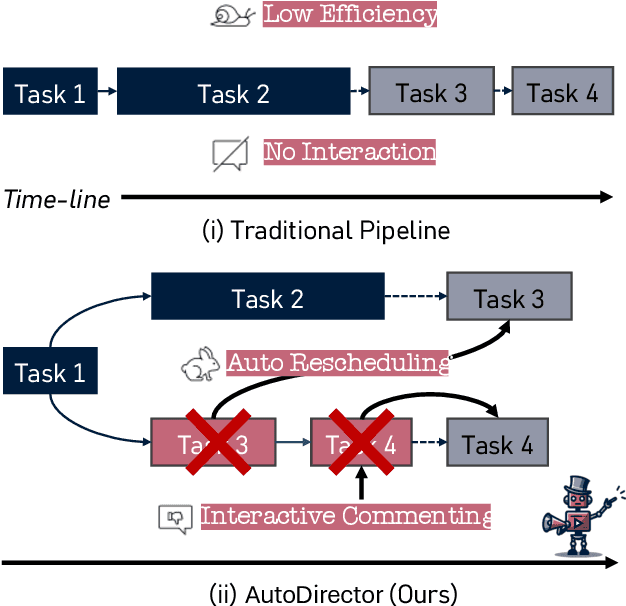



Abstract:With the advancement of generative models, the synthesis of different sensory elements such as music, visuals, and speech has achieved significant realism. However, the approach to generate multi-sensory outputs has not been fully explored, limiting the application on high-value scenarios such as of directing a film. Developing a movie director agent faces two major challenges: (1) Lack of parallelism and online scheduling with production steps: In the production of multi-sensory films, there are complex dependencies between different sensory elements, and the production time for each element varies. (2) Diverse needs and clear communication demands with users: Users often cannot clearly express their needs until they see a draft, which requires human-computer interaction and iteration to continually adjust and optimize the film content based on user feedback. To address these issues, we introduce AutoDirector, an interactive multi-sensory composition framework that supports long shots, special effects, music scoring, dubbing, and lip-syncing. This framework improves the efficiency of multi-sensory film production through automatic scheduling and supports the modification and improvement of interactive tasks to meet user needs. AutoDirector not only expands the application scope of human-machine collaboration but also demonstrates the potential of AI in collaborating with humans in the role of a film director to complete multi-sensory films.
Rho-1: Not All Tokens Are What You Need
Apr 11, 2024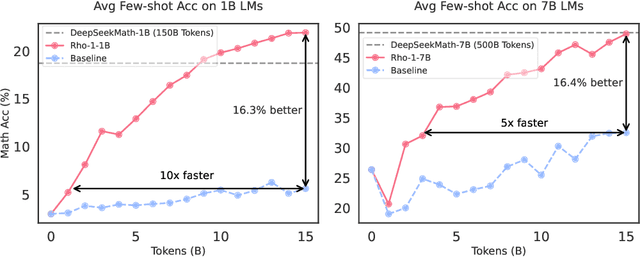
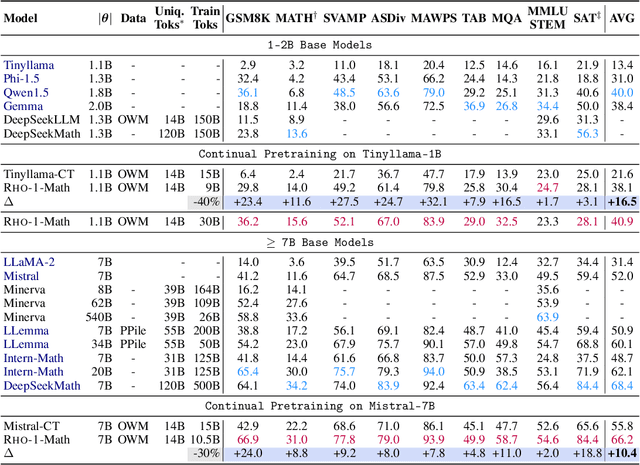
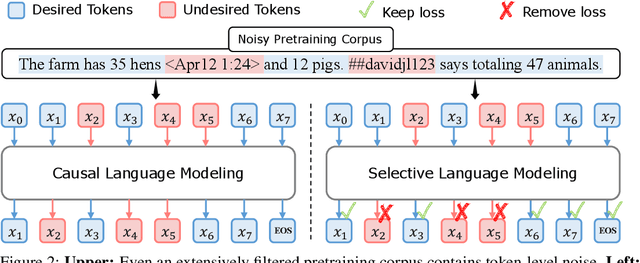
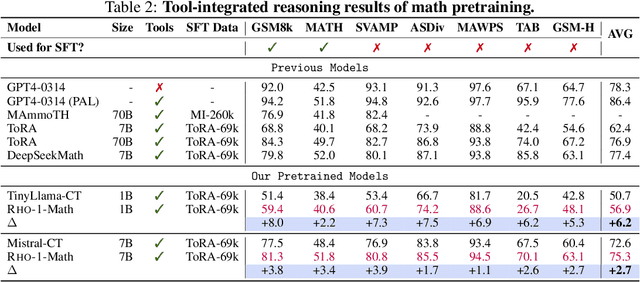
Abstract:Previous language model pre-training methods have uniformly applied a next-token prediction loss to all training tokens. Challenging this norm, we posit that "Not all tokens in a corpus are equally important for language model training". Our initial analysis delves into token-level training dynamics of language model, revealing distinct loss patterns for different tokens. Leveraging these insights, we introduce a new language model called Rho-1. Unlike traditional LMs that learn to predict every next token in a corpus, Rho-1 employs Selective Language Modeling (SLM), which selectively trains on useful tokens that aligned with the desired distribution. This approach involves scoring pretraining tokens using a reference model, and then training the language model with a focused loss on tokens with higher excess loss. When continual pretraining on 15B OpenWebMath corpus, Rho-1 yields an absolute improvement in few-shot accuracy of up to 30% in 9 math tasks. After fine-tuning, Rho-1-1B and 7B achieved state-of-the-art results of 40.6% and 51.8% on MATH dataset, respectively - matching DeepSeekMath with only 3% of the pretraining tokens. Furthermore, when pretraining on 80B general tokens, Rho-1 achieves 6.8% average enhancement across 15 diverse tasks, increasing both efficiency and performance of the language model pre-training.
LVLM-Intrepret: An Interpretability Tool for Large Vision-Language Models
Apr 03, 2024



Abstract:In the rapidly evolving landscape of artificial intelligence, multi-modal large language models are emerging as a significant area of interest. These models, which combine various forms of data input, are becoming increasingly popular. However, understanding their internal mechanisms remains a complex task. Numerous advancements have been made in the field of explainability tools and mechanisms, yet there is still much to explore. In this work, we present a novel interactive application aimed towards understanding the internal mechanisms of large vision-language models. Our interface is designed to enhance the interpretability of the image patches, which are instrumental in generating an answer, and assess the efficacy of the language model in grounding its output in the image. With our application, a user can systematically investigate the model and uncover system limitations, paving the way for enhancements in system capabilities. Finally, we present a case study of how our application can aid in understanding failure mechanisms in a popular large multi-modal model: LLaVA.
Exploring the Mystery of Influential Data for Mathematical Reasoning
Apr 01, 2024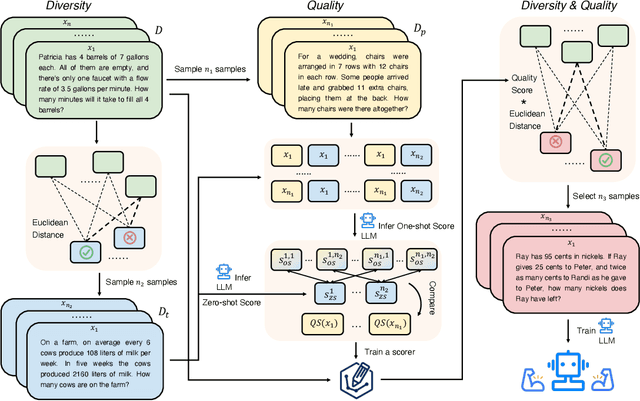
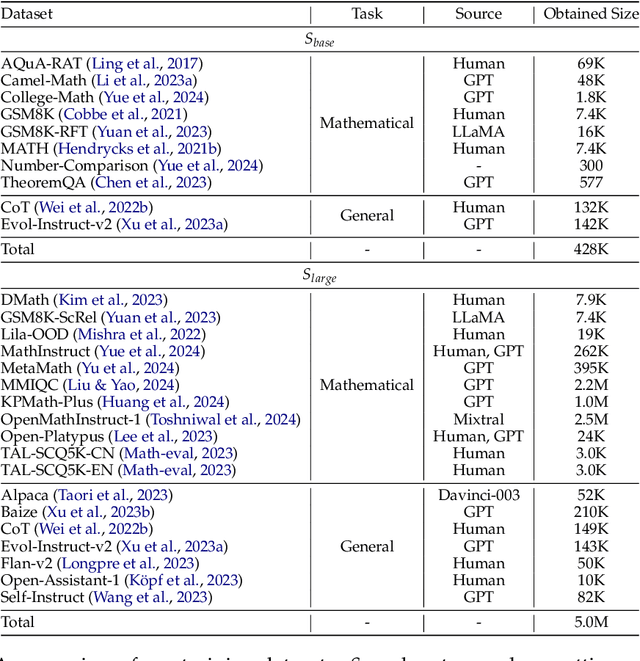

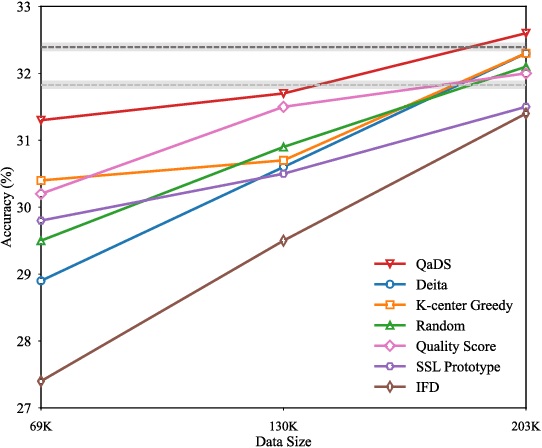
Abstract:Selecting influential data for fine-tuning on downstream tasks is a key factor for both performance and computation efficiency. Recent works have shown that training with only limited data can show a superior performance on general tasks. However, the feasibility on mathematical reasoning tasks has not been validated. To go further, there exist two open questions for mathematical reasoning: how to select influential data and what is an influential data composition. For the former one, we propose a Quality-aware Diverse Selection (QaDS) strategy adaptable for mathematical reasoning. A comparison with other selection strategies validates the superiority of QaDS. For the latter one, we first enlarge our setting and explore the influential data composition. We conduct a series of experiments and highlight: scaling up reasoning data, and training with general data selected by QaDS is helpful. Then, we define our optimal mixture as OpenMathMix, an influential data mixture with open-source data selected by QaDS. With OpenMathMix, we achieve a state-of-the-art 48.8% accuracy on MATH with 7B base model. Additionally, we showcase the use of QaDS in creating efficient fine-tuning mixtures with various selection ratios, and analyze the quality of a wide range of open-source datasets, which can perform as a reference for future works on mathematical reasoning tasks.
PPTC-R benchmark: Towards Evaluating the Robustness of Large Language Models for PowerPoint Task Completion
Mar 06, 2024Abstract:The growing dependence on Large Language Models (LLMs) for finishing user instructions necessitates a comprehensive understanding of their robustness to complex task completion in real-world situations. To address this critical need, we propose the PowerPoint Task Completion Robustness benchmark (PPTC-R) to measure LLMs' robustness to the user PPT task instruction and software version. Specifically, we construct adversarial user instructions by attacking user instructions at sentence, semantic, and multi-language levels. To assess the robustness of Language Models to software versions, we vary the number of provided APIs to simulate both the newest version and earlier version settings. Subsequently, we test 3 closed-source and 4 open-source LLMs using a benchmark that incorporates these robustness settings, aiming to evaluate how deviations impact LLMs' API calls for task completion. We find that GPT-4 exhibits the highest performance and strong robustness in our benchmark, particularly in the version update and the multilingual settings. However, we find that all LLMs lose their robustness when confronted with multiple challenges (e.g., multi-turn) simultaneously, leading to significant performance drops. We further analyze the robustness behavior and error reasons of LLMs in our benchmark, which provide valuable insights for researchers to understand the LLM's robustness in task completion and develop more robust LLMs and agents. We release the code and data at \url{https://github.com/ZekaiGalaxy/PPTCR}.
 Add to Chrome
Add to Chrome Add to Firefox
Add to Firefox Add to Edge
Add to Edge